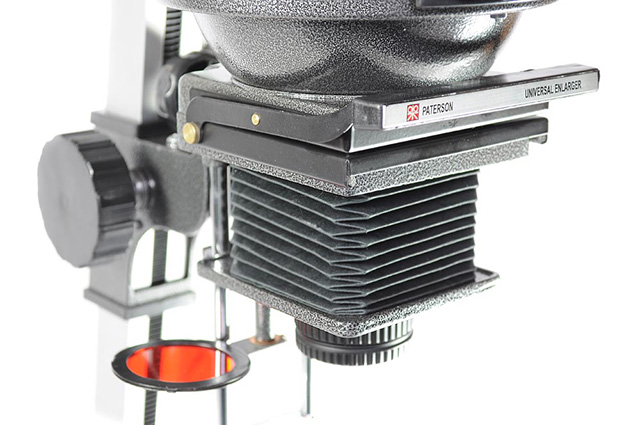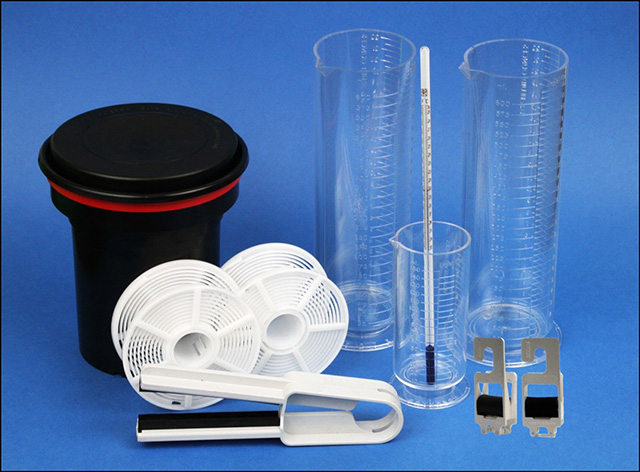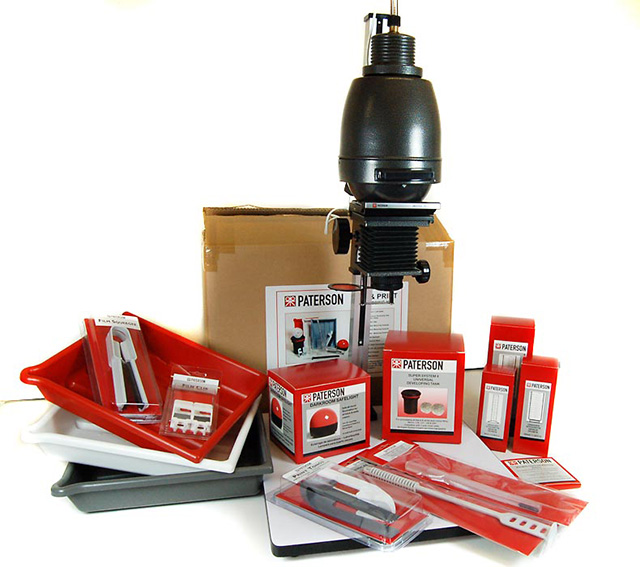How To Create A Dark Room
Read Time: 12 mins Languages:
Building your own darkroom to develop film and paper might seem tedious in these digital days. However, if you have the time and space, it can be a rewarding experience that will help you better understand photography.

Many of those born and raised in this digital era haven't experience the magic of the darkroom, and in that sense, building your own can be a "going back to the roots" experience that will give you a solid background in yesterdays techniques when it comes to photography.
There's no reason to defend one medium against the other, both have their virtues and drawbacks, but the preparations to build your own darkroom and to develop your films and create prints will give not only be an adventure in terms of knowledge, it will be a rewarding and fun activity that may reveal new horizons in your own photography.
Let's build a darkroom on a budget!

Choosing the Right Space
Creating a darkroom means having a spare room in the house that can be used. The preference is a permanent space, but it is also possible to convert a room temporarily for a day or two or work. The permanent space does not have to be large, a 5x5 foot closet can be made to work.
It's also important to note, that you don't actually need a darkroom to develop film. However, a darkroom is required for printing.
When I started printing, at 15, I used my parents wash closet to make contact prints. It was my first endeavour into photography. Then I used a friend's darkroom, until I bought an enlarger and started to do my own printing at home, again, in a wash closet.
A second bathroom or closet can be turned into a darkroom fairly easily. Running water is a huge help, but not required. It must be able to be darkened so no light enters. When I got my first apartment, I created a permanent darkroom in a second, rather large wash closet, which I kept for some years.
As I mentioned, you'll need water, at the very least in buckets, trays. Kitchens should be avoided, as it is not a good idea to mix the chemicals for the darkroom work with areas where food is prepared. It does not matter how careful you are, it is a bad idea to mix your passion with your cooking area.
You'll also need to have at least one electrical outlet for your enlarger and other equipment used.

Making Your Darkroom Light Tight
Developing your photographs at night might seem like a good idea, until you discover that darkroom work can take hours, and you may not always have a time schedule or feel in the mood to spend nights in the dark out of bed! Not only that, but if your room has a window, light from the street will still cause problems.
You need to make the room light tight. For this reason a room in a basement, or with a small window is easier to transform into a darkroom. Use black curtains and blackout sheeting or products like Magic Blackout Blinds to keep light out.
Once you've set up your room, turn all lights off and wait for a few minutes so your eyes adjust. It won't be hard to find out if your darkroom is light tight. Even the slightest leaks can cause problems with light sensitive photo paper.

Safety is a Priority
Your darkroom will need some form of ventilation. Staying in a room for hours with the fumes from the chemicals is not good for your health. If you are using a bathroom, the bathroom fan should be enough. In a permanent darkroom, you'll do best to install some form of exhausting for the fumes. Small fans specifically for this purpose are available.
Also, remember to use gloves to touch chemicals. Although they may make you drop something now and then, they protect your skin. Continuous immersion of your hands in the chemicals used is not good for your health. Some people have reactions to the chemicals immediately, breaking out in a rash.
Divide Your Darkroom into Wet and Dry Areas
Once you've found the right place for your darkroom, you need to define two areas: dry and wet. In the dry area, near an electric outlet, you'll have the enlarger, tools, and paper. On the wet side, you'll have the developing trays, water, film developing tanks and chemicals. This separation keeps chemicals off your paper and film until you want them there. It also keeps liquids away from any electronics associated with the enlarger.
Remember to always have a tray or sink with water to rinse your hands when moving from the wet back to the dry area, and to change this water frequently for long sessions. Hand towels, preferably paper, are a must.
If you're the happy owner of a permanent darkroom, keep your developing materials inside your darkroom. Place the paper in the dry area, on shelves above or below the working table, and the chemicals in the wet area, usually in a cabinet under the area where you've the developing trays.
Some people will have enough space to create two distinct areas, with a corridor in the middle. If you've that option, go for it. If you don't, try the best you can. Just be sure that while you're moving wet paper and trays around, you aren't crossing over your enlarger or paper supply.

The Enlarger is the Heart of the Darkroom
Invest in a good enlarger, but do not buy more than you think you'll need. When I started I bought a portable enlarger, the Russian Zenith UPA-5M, which was popular in the seventies, because it could be taken anywhere in its case, which doubled as a baseboard. It was not a good enlarger, but an intelligent solution picked by some photographers on the move that needed to develop their images in a hotel room, for example.
While studying photography at school I had Durst enlargers to play with, and also at some labs I worked in. For my own needs at home, I used Meopta enlargers, which was a brand well known among photographers in Europe, and finally settled for a Meopta Opemus III which could deal with 35mm and 6x6 films.
It is advisable to buy an enlarger that can accept film sizes above 35mm, just in case you get happen to expand into medium format film. If you're buying on a budget, it makes no sense to buy an enlarger for formats above that, like 6x7 or 6x9cm, as you'll probably never use them. However, if you do want to experiment with large format 4x5 negatives and the like, you can find used equipment for next to nothing. An enlarger that cost $1000 in 1980, might only cost $150-200 now on the used market.
Remember that lenses for enlargers are sometimes bought separately, so be prepared for that extra expense.
Developing Film and Prints at Home
If you're starting out, black and white is the best option to start with. You can always buy an enlarger that is ready for colour, but black & white will be easier to control and will give you the chance to understand the essential aspects of darkroom work.
You'll probably want to develop your own black & white films at home and I advise you to do so. You'll need developing tanks and a few other pieces of equipment, and while you can search for second-hand bargains, sometimes it is better, and faster, to buy a kit that will offer all you need to start right away.
If you already have bought your enlarger, and want a one packet solution, then the Paterson Processing kit contains everything you require for film and prints except the chemicals. The kit includes everything on the following list. This provides a good place to start if you're shopping for things individually, too.
- A universal developing tank for 35mm or 120 film
- Two film reels
- Three 8 x 10" developing trays
- A Paterson safelight
- A 600ml graduated measuring cylinder
- A 300ml graduated measuring cylinder
- A 45ml graduated measuring cylinder
- A 9" Thermometer
- Two print tongs
- Film clips
- A film squeegee

The Complete Darkroom Kit
If you have the time and experience to look for second hand options, go for it. If you want to try your hand in the darkroom and want to do it now, then one of the best options might be a processing and enlarging kit.
The kit will include the materials mentioned above and an enlarger, negative carrier, lens, filters, switch and possibly a timer. Again, checking out these kits also makes a good shopping list if your buying things separately.
The enlarger itself may or may not come with a base. Unless you're handy, get one with a base. Leveling an enlarger on a homemade base can be quite a chore. The lens will usually be a 50mm suitable for printing 35mm film. For medium format film (check to be sure your enlarger can handle it), you'll need a 75mm lens. For 4x5 film, you'll need a 135mm.
Negative carriers are important, they hold your film in the enlarger. They are specific to the film size. You can't use the same one for 35mm and medium format.
The most common way to print black and white is to use variable contrast paper. In order to alter the contrast of your print, you'll need a set of variable grade filters. These often come with kits. If you're buying them separately, you'll need to make sure to buy ones the fit in the filter carrier of your enlarger.
The last thing you'll need a switch and timer. In order to control the exposure of your print, you need to control the amount of time the image is projected onto the paper, just like a shutter speed when using a camera. A switch simply turns the enlarger on and off. You'll have to have an external timer or just guess at the time. This is very hard and not recommended. You'll need an enlarger timer. This will have knobs or a digital display allowing you to choose the time for the exposure.
If you're shopping second hand, trying to get an enlarger that comes with most of these things. Finding replacement negative carriers can be hard. Finding lenses is easy, but can be expensive. Filters are easy to find as they should be replaced every few years. Timers are easy to find on eBay, and you don't always have to buy the same brand as your enlarger.

Chemicals
When you decide to have a darkroom you've to think of two important aspects. You've to keep buying chemicals to keep the fun active, and that can get a little expensive in the long run. It is also one of the reasons why more people have a black & white instead of colour darkroom. The chemicals for black and white are cheaper and less sensitive to temperature and light.
For black and white processing, you'll need a film developer, a paper developer and a fixer that can be used in both processes. A stop bath is helpful when printing, but not required. A clearing agent like Photo Flo is helpful when developing film, but also not required.
Most chemicals last about six months if stored properly, though there are exceptions. Some last much longer, some much shorter.
You'll also need to think of ways to get rid of the chemicals once they're exhausted. Some are toxic and it can be illegal to pour down the drain. Properly dispose of photographic processing chemicals in accordance with local sewer discharge regulations. You can buy big five or ten gallon jugs to hold exhausted chemicals in until you can make a trip to a proper place to get rid of them.
If you want to know more about darkroom building, a good source of information is Kodak's Darkroom Design for Amateur Photographers Pamphlet.
Does a Darkroom Make Sense in a Digital World
I have very fond memories of my darkroom times, and remember developing the photos I made of my first son some 23 years ago. The first pictures I sold to newspapers, well over 30 years ago, were first seen under the light of my darkroom. I've not thought about setting up a darkroom for a long time, but I must admit this last year I have given the idea some thought.
I was invited to prepare a series of photography lessons for 2014 to help people get a better grasp of photography. There is some space for a darkroom at the institution I work with, and I've suggested that a darkroom could be an interesting feature of a digital photography course.
There is in fact some magic in the way an image forms on a sheet of paper. Building your own darkroom having never used one is a daunting proposition. I suggest searching for a local camera club or taking a class a local university. It will not only be a rewarding experience, it will help you to understand how digital photography has changed everything. If you get them darkroom bug, then you'll need to clear out that basement room and get building.

Jose Antunes is a freelance writer and photographer based in Portugal. Besides writing about the technical and creative aspects of photography for various publications, he leads workshops and leads photo tours to reveal the hidden perspectives from his country. "Less Gear, More Fun" is an important idea for him.
How To Create A Dark Room
Source: https://photography.tutsplus.com/tutorials/how-to-build-a-low-budget-darkroom--photo-14293
Posted by: kellyanowbod1944.blogspot.com

0 Response to "How To Create A Dark Room"
Post a Comment